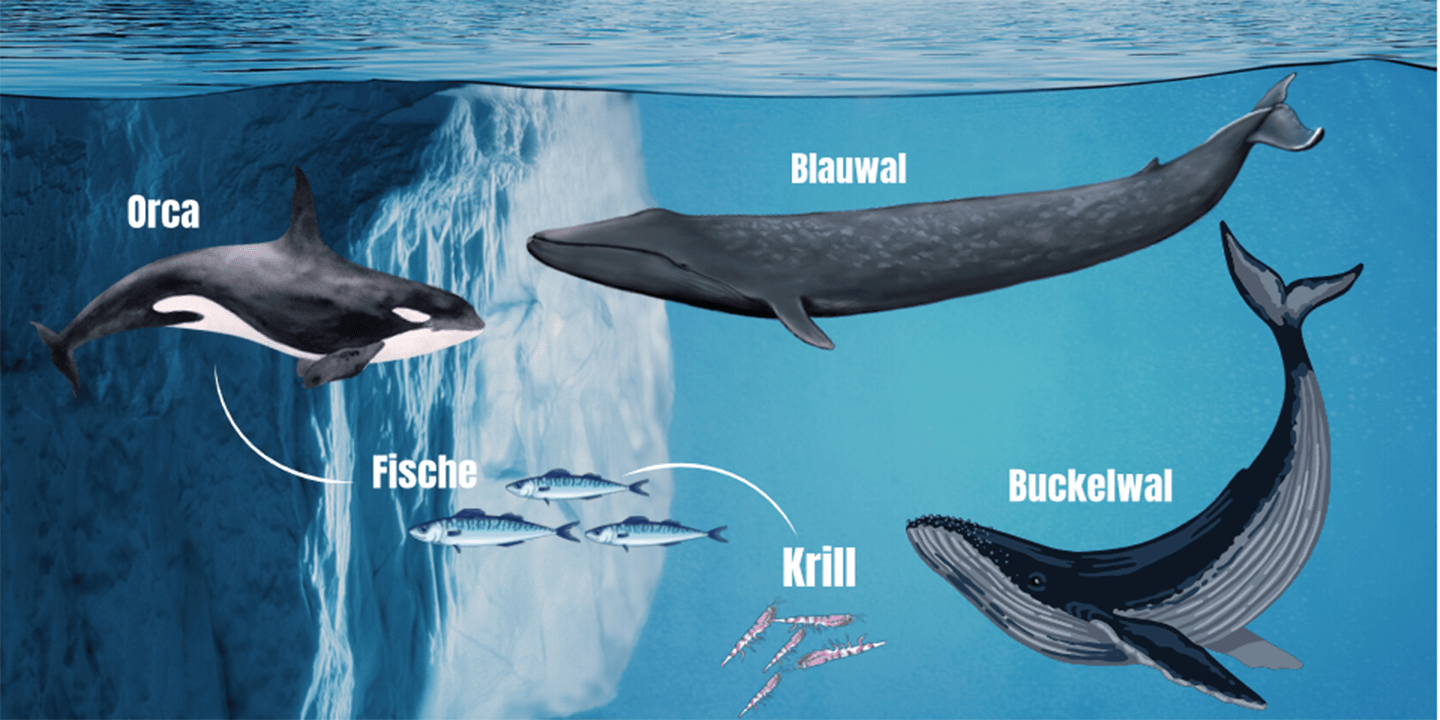Two detailed presentations (held in German), developed by two young scientists, enable teachers to find an exciting introduction to the topic of marine biodiversity with their pupils. Specifically, they deal with whale research, the food web in the Antarctic and the special ability of whales to hear and utilise sound waves.
Jasmin Groß is a food web ecologist at HIFMB, Elena Schall is a bioacoustician at AWI, and both are keen to share their research not only within the scientific community, but also and especially beyond.
This is the motivation behind the presentations. The presentations with detailed accompanying notes can be freely downloaded and used. In addition, the researchers also offer to give the presentations themselves in class (on site or online) and answer questions from the class afterwards.
The Antarctic food web is a complex system of interactions between different organisms in the Antarctic. In this unique ecosystem, krill, small crustaceans, play a central role as the main food source for many animals, including fish, birds and whales.
The food chain begins with phytoplankton, which use sunlight to photosynthesise and produce glucose as a basic source of energy. Krill feed on this phytoplankton and in turn serve as food for various species of fish, penguins, seals and whales. The question is always: who is the hunter and who is the prey?
The Antarctic food web is very sensitive to changes, especially in connection with climate change. Changes in ice dynamics, ocean structure and food availability can have an impact on the entire food web and affect the balance of the ecosystem. At AWI and HIFMB, we are investigating these relationships by sampling whales at the top of the food web to gain insights into the entire food web. To do this, we analyse the composition of whale fat tissue, which contains a lot of information about when, where and what a whale has eaten in its life. This allows us to better understand how the Antarctic food web works and how it reacts to environmental changes.
The ability of whales to hear sound waves plays a crucial role in their survival and behaviour. Whales use sound for various purposes, including communication, navigation and locating prey.
Toothed whales even use a very special ability to orientate themselves in their environment and find food. This process is called echolocation and involves emitting sound pulses that are reflected by objects in the environment. Based on the returning echoes, the whales can then determine the distances, sizes and shapes of objects.
The ability to perceive sound waves is particularly important in the often dark and deep oceans, where vision is limited, but the sperm whale goes hunting for giant squid, for example. However, the chances of success in this hunt can be considerably reduced if the ocean becomes too loud due to man-made noise, such as the sound of ships. This is because ship noise can interfere with the echolocation signals of sperm whales and their echoes and therefore impair the whales’ ability to precisely locate prey.
We explain how AWI’s research is helping to understand the distribution and behaviour of different marine mammals using underwater acoustic recordings in the polar seas. The knowledge gained is crucial for the protection of vulnerable polar ecosystems because the management of human activities, such as shipping and fishing, can be better designed to minimise impacts on animals and their habitats.
The Antarctic food web is a complex system of interactions between different organisms in the Antarctic. In this unique ecosystem, krill, small crustaceans, play a central role as the main food source for many animals, including fish, birds and whales.
The food chain begins with phytoplankton, which use sunlight to photosynthesise and produce glucose as a basic source of energy. Krill feed on this phytoplankton and in turn serve as food for various species of fish, penguins, seals and whales. Antarctic sea ice is an important factor in the life cycles of almost all Antarctic marine animals.
The Antarctic food web is very sensitive to changes, especially in connection with climate change. Changes in ice dynamics, ocean structure and food availability can have an impact on the entire food web and affect the balance of the ecosystem. At AWI and HIFMB, we are investigating these relationships by sampling whales at the top of the food web to gain insights into the entire food web. To do this, we analyse the composition of whale fat tissue, which contains a lot of information about when, where and what a whale has eaten in its life. This allows us to better understand how the Antarctic food web works and how it reacts to environmental changes.
We explain how AWI’s research is helping to understand the distribution and behaviour of different marine mammals using underwater acoustic recordings in the polar seas. The knowledge gained is crucial for the protection of vulnerable polar ecosystems because the management of human activities, such as shipping and fishing, can be better designed to minimise impacts on animals and their habitats.
The Scientists

Jasmin Groß uses samples from the skin of whales to investigate what humpback whales eat, where they do it and why. Stable isotopes in the samples provide her with information about this. With her research, she is investigating the questions of how carbon circulates through different trophic levels in the Southern Ocean and whether whales can contribute to combating climate change. Because whales feed at depth but only excrete at the surface, they bring important nutrients to the surface through their faeces, which can be used by phytoplankton. This leads to a higher biomass of phytoplankton and therefore more carbon dioxide consumption.
Mail: jasmin.gross@hifmb.de

Elena Schall is a marine biologist specialised in bioacoustics. She develops algorithms to analyse passive acoustic data (sounds recorded by underwater microphones over months in the Arctic and Antarctic). The analysis provides information about the occurrence of various marine animals and helps to answer ecological questions. As part of her doctoral thesis, Elena Schall modelled the effects of climate fluctuations on the acoustic presence of humpback whales and estimated the similarity of songs as an indicator of the exchange between populations. She is currently working on using artificial intelligence to recognise and classify passive acoustic marine data, both for biological and anthropogenic sounds.
Mail: elena.schall@awi.de
